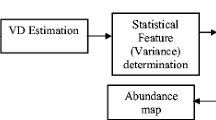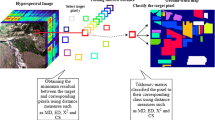Abstract
A sparse nonnegative matrix factorization method with the thresholded ground distance (SNMF-TEMD) is proposed to solve the band selection problem in hyperspectral imagery (HSI) classification. The SNMF-TEMD assumes that band vectors are sampled from a union of low-dimensional subspaces and approximates a HSI data matrix with the product of a basis matrix constructed from subspaces and a sparse coefficient matrix. The SNMF-TEMD utilizes the TEMD metric to better measures approximation errors during the optimization of HSI data factorization. The TEMD metric makes up the theoretical drawbacks in the Euclidean distance (ED) and Kullback–Leibler divergence (KLD) metrics when measuring the approximation errors in HSI datasets. The SNMF-TEMD is solved by the combination of min-cost-flow algorithm and multiplicative update rules. The band cluster assignments are found according to positions of largest entries in columns of the coefficient matrix and the desired band subset constitutes with the bands closest to their cluster centers. Three groups of experiments on two HSI datasets are performed to explore the performance of SNMF-TEMD. Four popular band selection methods are used to make comparisons: affinity propagation (AP), maximum-variance principal component analysis (MVPCA), SNMF with ED metric (SNMF-ED) and SNMF with KLD metric (SNMF-KLD). Experimental results show that SNMF-TEMD outperforms all four methods in classification accuracy and its computational speed is slower than SNMF-ED and SNMF-KLD. SNMF-TEMD is a better choice for band selection among all five methods because of its overwhelming advantage in classification and the popular speed remedy scheme from parallel computing and high-performance computers.



Similar content being viewed by others
References
Ahuja RK, Magnanti TL, Orlin JB (1993) Network flows: theory, algorithms, and applications. Englwood Cliffs, New Jersey
Arzuaga-Cruz E, Jimenez-Rodriguez LO, Velez-Reyes M (2003) Unsupervised feature extraction and band subset selection techniques based on relative entropy criteria for hyperspectral data analysis. AeroSense 2003:462–473
Ball JE, West T, Prasad S, Bruce LM (2007) Level set hyperspectral image segmentation using spectral information divergence-based best band selection. Proceedings of 2007 I.E. International Geoscience and Remote Sensing Symposium (IGARSS 2007) 4053–4056
Cai D, He X, Han J, Huang TS (2011) Graph regularized nonnegative matrix factorization for data representation. IEEE Transactions on Pattern Analysis and Machine Intelligence 33(8):1548–1560
Candes EJ, Romberg JK, Tao T (2006) Stable signal recovery from incomplete and inaccurate measurements. Commun Pure Appl Math 59(8):1207–1223
Chang C-I, Du Q, Sun T-L, Althouse ML (1999) A joint band prioritization and band-decorrelation approach to band selection for hyperspectral image classification. IEEE Trans Geosci Remote Sens 37(6):2631–2641
Chang C-I, Wang S (2006) Constrained band selection for hyperspectral imagery. IEEE Trans Geosci Remote Sens 44(6):1575–1585
Cover T, Hart P (1967) Nearest neighbor pattern classification. IEEE Trans Inf Theory 13(1):21–27
Donoho D, Stodden V (2004) When does non-negative matrix factorization give a correct decomposition into parts? Advances in Neural Information Processing Systems 2004:1141–1148
Du B, Zhang L (2014a) Target detection based on a dynamic subspace Pattern Recognition 47:344–358
Du B, Zhang L (2014b) A Discriminative Metric Learning Based Anomaly Detection Method IEEE Transactions on Geoscience and Remote Sensing 52(11):6844–6857
Du H, Qi H, Wang X, Ramanath R, Snyder WE (2003) Band selection using independent component analysis for hyperspectral image processing. Proceedings of 32nd IEEE Applied Imagery Pattern Recognition Workshop 93–98
Du Q (2003) Band selection and its impact on target detection and classification in hyperspectral image analysis. Proceedings of 2003 I.E. Workshop on Advances in Techniques for Analysis of Remotely Sensed Data 374–377
Du Q, Bioucas-Dias JM, Plaza A (2012) Hyperspectral band selection using a collaborative sparse model. Proceedings of 2012 I.E. International Geoscience and Remote Sensing Symposium (IGARSS) 3054–3057
Gao Y, Church G (2005) Improving molecular cancer class discovery through sparse non-negative matrix factorization. Bioinformatics 21(21):3970–3975
Goldberg AV (1997) An efficient implementation of a scaling minimum-cost flow algorithm. Journal of Algorithms 22(1):1–29
Guan N, Tao D, Luo Z, Yuan B (2011) Manifold regularized discriminative nonnegative matrix factorization with fast gradient descent. IEEE Trans Image Process 20(7):2030–2048
Guan N, Tao D, Luo Z, Yuan B (2012) NeNMF: an optimal gradient method for nonnegative matrix factorization. IEEE Trans Signal Process 60(6):2882–2898
Guo B, Gunn SR, Damper R, Nelson J (2006) Band selection for hyperspectral image classification using mutual information. IEEE Geosci Remote Sens Lett 3(4):522–526
Hazan T, Shashua A (2007) Analysis of L2-loss for probabilistically valid factorizations under general additive noise. Technical Report 2007–13, The Hebrew University
Hoyer PO Non-negative sparse coding (2002). Proceedings of the 12th IEEE Workshop on Neural Networks for Signal Processing 557–565
Hoyer PO (2004) Non-negative matrix factorization with sparseness constraints The. J Mach Learn Res 5:1457–1469
Jia S, Qian Y (2009) Constrained nonnegative matrix factorization for hyperspectral unmixing. IEEE Trans Geosci Remote Sens 47(1):161–173
Karavasilis V, Nikou C, Likas A (2011) Visual tracking using the. Earth Mover's Distance between Gaussian mixtures and Kalman filtering Image and Vision Computing 29(5):295–305
Keith DJ, Schaeffer BA, Lunetta RS, Gould RW Jr, Rocha K, Cobb DJ (2014) Remote sensing of selected water-quality indicators with the hyperspectral imager for the coastal ocean (HICO) sensor. Int J Remote Sens 35(9):2927–2962
Keshava N (2004) Distance metrics and band selection in hyperspectral processing with applications to material identification and spectral libraries. IEEE Trans Geosci Remote Sens 42(7):1552–1565
Kim H, Park H (2007) Sparse non-negative matrix factorizations via alternating non-negativity-constrained least squares for microarray data analysis. Bioinformatics 23(12):1495–1502
Kundu MK, Chowdhury M, Banerjee M (2012) Interactive image retrieval using M-band wavelet, earth mover’s distance and fuzzy relevance feedback. International Journal of Machine Learning and Cybernetics 3(4):285–296
J-m L, Y-t Q (2011) Clustering-based hyperspectral band selection using sparse nonnegative matrix factorization. Journal of Zhejiang University SCIENCE C 12(7):542–549
Li L, Zhang Y (2009) SENSC. A stable efficient algorithm for nonnegative sparse coding Acta Automatica Sinica 35(10):1257–1271
Matlab 2013b (2013). Natick, MA: Mathworks. http://www.mathworks.com
Melgani F, Bruzzone L (2004) Classification of hyperspectral remote sensing images with support vector machines IEEE Transactions on Geoscience and Remote Sensing 42:1778–1790
Morup M, Madsen KH, Hansen LK Approximate L0 constrained non-negative matrix and tensor factorization. Proceedings of IEEE International Symposium on Circuits and Systems (ISCAS 2008) 1328–1331
Murphy RJ, Monteiro ST (2013) Mapping the distribution of ferric iron minerals on a vertical mine face using derivative analysis of hyperspectral imagery (430–970 nm). ISPRS J Photogramm Remote Sens 75:29–39
Peharz R, Pernkopf F (2012) Sparse nonnegative matrix factorization with L0-constraints. Neurocomputing 80:38–46
Pele O, Werman M Fast and robust earth mover's distances (2009). Proceddings of 2009 I.E. 12th international conference on Computer vision 460–467
Qian Y, Yao F, Jia S (2009) Band selection for hyperspectral imagery using affinity propagation. IET Comput Vis 3(4):213–222
Ramirez C, Kreinovich V, Argaez M (2013) Why L1 Is a Good Approximation to L0. A Geometric Explanation Journal of Uncertain Systems 7(3):203–207
Ren Z, Yuan J, Zhang Z (2011) Robust hand gesture recognition based on finger-earth mover's distance with a commodity depth camera. Proceedings of the 19th ACM international conference on Multimedia 1093–1096
Rubner Y, Tomasi C (2000) Perceptual metrics for image database navigation vol 1. Springer
Sandler R, Lindenbaum M (2011) Nonnegative matrix factorization with Earth mover's distance metric for image analysis IEEE Transactions on Pattern. Analysis and Machine Intelligence 33(8):1590–1602
Shi B, Chen N, Sun W (2014) Sparse Nonnegative Matrix Factorization for Hyperspectral Optimal Band Selection Acta Geodaetica et Cartographica Sinica 42(3):351–358 [in Chinese]
Steinwart I, Christmann A (2008) Support vector machines. Springer, Verlag
Sun W, Halevy A, Benedetto J, Czaja W, Liu C, Wu H, Shi B, Li W (2014) UL-Isomap based nonlinear dimensionality reduction for hyperspectral imagery classification ISPRS. Journal of Photogrammetry and Remote Sensing 89:25–36
Tong X, Xie H, Weng Q (2013) Urban land cover classification with airborne hyperspectral data: what features to Use? IEEE Journal of Selected Topics in Applied Earth Observations and Remote Sensing 99:1–12
Wang T, Du B, Zhang L (2013) A kernel-based target-constrained interference-minimized filter for hyperspectral sub-pixel target detection. IEEE Journal of Selected Topics in Applied Earth Observations and Remote Sensing 6:626–637
Wang Y-X, Zhang Y-J (2013) Nonnegative matrix factorization. A comprehensive review IEEE Transactions on Knowledge and Data Engineering 25(6):1336–1353
Wen J, Tian Z, Liu X, Lin W (2013) Neighborhood preserving orthogonal. PNMF feature extraction for hyperspectral image classification IEEE Journal of Selected Topics in Applied Earth Observations and Remote Sensing 6(2):759–768
Wen J, Zhao Y, Zhang X, Yan W, Lin W (2014) Local discriminant non-negative matrix factorization feature extraction for hyperspectral image classification. Int J Remote Sens 35(13):5073–5093
Xia W, Wang B, Zhang L (2013) Band selection for hyperspectral imagery: a new approach based on complex networks. IEEE Geosci Remote Sens Lett 10(5):1229–1233
Xiao Z, Bourennane S (2014) Constrained nonnegative matrix factorization and hyperspectral image dimensionality reduction. Remote Sensing Letters 5(1):46–54
Yang H, Du Q, Su H, Sheng Y (2011a) An efficient method for supervised hyperspectral band selection. IEEE Geosci Remote Sens Lett 8(1):138–142
Yang Z, Zhou G, Xie S, Ding S, Yang J-M, Zhang J (2011b) Blind spectral unmixing based on sparse nonnegative matrix factorization. IEEE Trans Image Process 20(4):1112–1125
Zhu F, Wang Y, Xiang S, Fan B, Pan C (2014) Structured Sparse Method for Hyperspectral Unmixing ISPRS Journal of Photogrammetry and Remote Sensing 88:101–118
Acknowledgment
This work was funded by National Nature Science Foundation of China (41401389, 41171073, 41471004), by Research Project of Zhejiang Educational Committee (Y201430436), by Ningbo Natural Science Foundation (2014A610173), by Natural Science Foundation of Zhejiang Province(Y5110321), by the Discipline Construction Project of Ningbo University (ZX2014000400) and by the K. C. Wong Magna Fund in Ningbo University. The authors would like to thank the editor and referees for their suggestions which improved the manuscript.
Author information
Authors and Affiliations
Corresponding author
Additional information
Communicated by: H. A. Babaie
Electronic supplementary material
Below is the link to the electronic supplementary material.
ESM 1
(DOC 913 kb)
Rights and permissions
About this article
Cite this article
Sun, W., Li, W., Li, J. et al. Band selection using sparse nonnegative matrix factorization with the thresholded Earth’s mover distance for hyperspectral imagery classification. Earth Sci Inform 8, 907–918 (2015). https://doi.org/10.1007/s12145-014-0201-3
Received:
Accepted:
Published:
Issue Date:
DOI: https://doi.org/10.1007/s12145-014-0201-3




